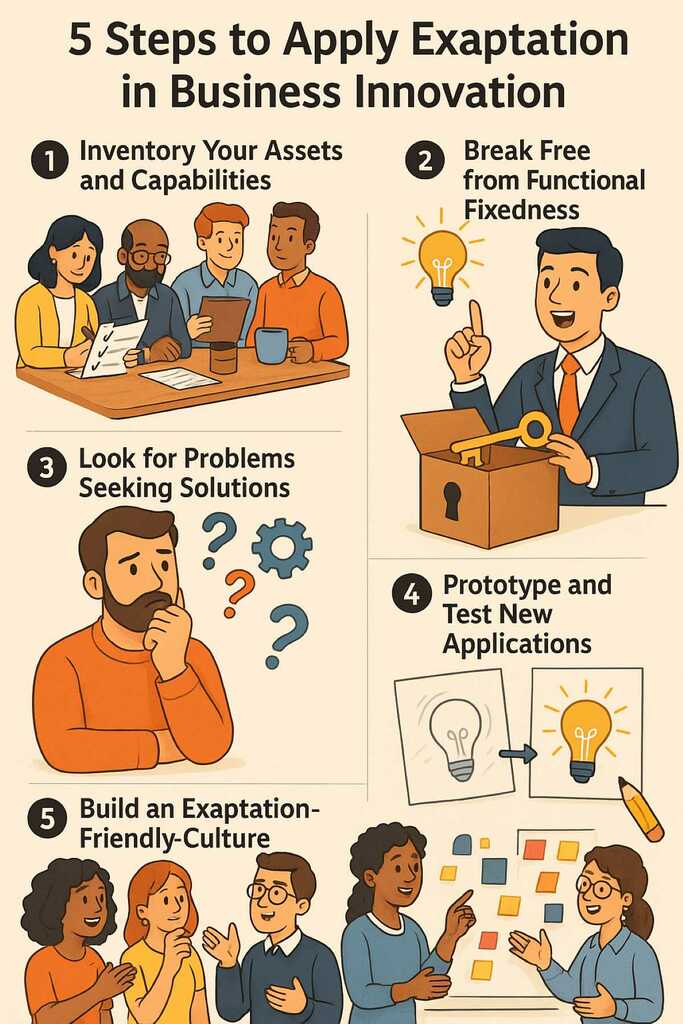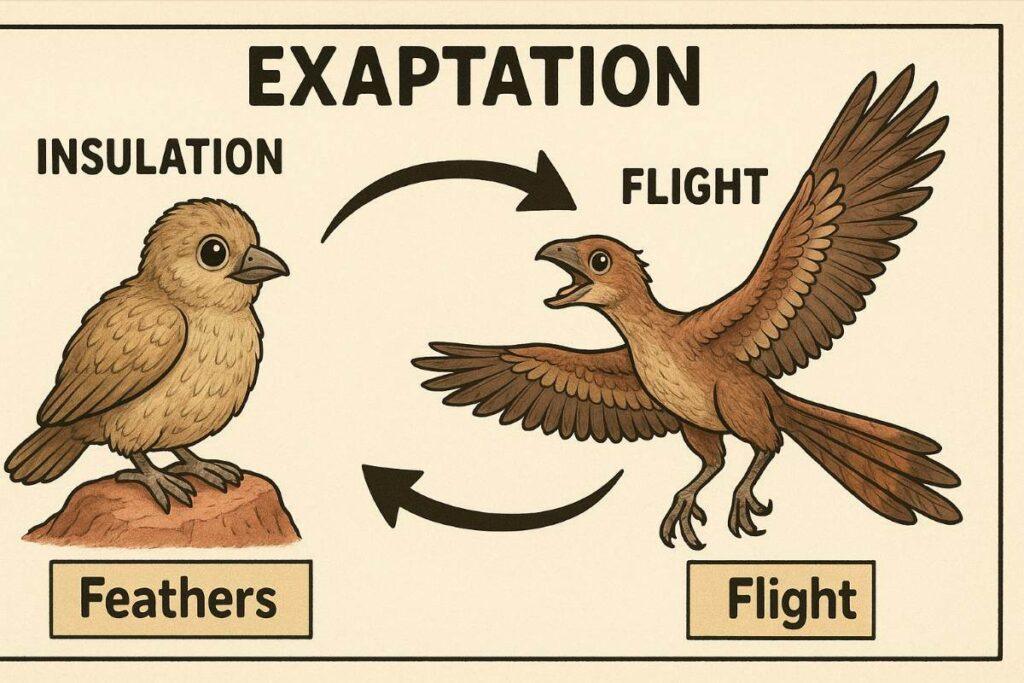Innovation often comes from using things in new ways, not just inventing new things. This idea is called the exaptation mental model. It comes from evolutionary biology and is now changing how companies like Uber, Microsoft, and 3M find breakthrough innovation.
Exaptation means finding new uses for things we already have. It’s about making the most of what we already know, without starting over. This way, companies can find new value without creating something entirely new.
This approach helps teams and leaders see the hidden value in what they already have. It keeps them ahead in a world that’s always changing. By using what they already know, they can innovate in new and exciting ways.
What Is Exaptation? Understanding the Concept
Exaptation is a term borrowed from evolutionary biology that describes a fascinating phenomenon: when a trait or feature that evolved for one purpose is repurposed to serve an entirely different function in the way that life adapts over time.
The concept was first introduced by paleontologists Stephen Jay Gould and Elisabeth Vrba in 1982 to explain evolutionary adaptations that weren’t direct products of natural selection for their current role.
The classic example from nature is bird feathers. Feathers didn’t initially evolve for flight—they first developed as insulation to regulate body temperature as part of their survival strategy.
Only later were they co-opted for the completely different function of flying. This wasn’t a planned adaptation but rather an opportunistic repurposing of an existing trait for a new advantage.
Exaptation vs. Adaptation: Understanding the Difference
While adaptation and exaptation might seem similar, they represent fundamentally different evolutionary processes:
Adaptation
- Develops specifically for its current function
- Direct result of natural selection
- Gradually refined for its specific purpose
- Follows a predictable evolutionary path
Exaptation
- Repurposed from a different original function
- Not initially selected for its current role
- Creates unexpected new capabilities
- Often leads to surprising innovations
This distinction is crucial because it highlights how innovation often comes not from creating something entirely new, but from seeing new potential in the things that already exist in our world. In business and technology, exaptation represents a powerful mental model for innovation that doesn’t require starting from scratch, allowing people to adapt ideas over time and embrace change in how they work.
The Exaptation Mental Model: A Framework for Innovation
As a mental model, exaptation provides a powerful framework for approaching innovation and problem-solving. Rather than always seeking to create something entirely new, the exaptation mental model encourages us to look at existing assets, technologies, or ideas and ask: “What else could this be used for?”
This approach has several advantages over traditional innovation methods:
- Lower activation energy: Repurposing existing elements requires less initial investment than creating something from scratch.
- Reduced risk: Working with proven components or concepts lowers the uncertainty compared to entirely new ventures.
- Unexpected connections: By looking at familiar things in new ways, you can discover opportunities others have missed.
- Faster implementation: Building on existing foundations often allows for quicker development and deployment.
Why Exaptation Outperforms Traditional Innovation in Uncertain Environments
In today’s fast-paced world, time, cost, and flexibility are key. Exaptation beats traditional innovation by using what’s already there. This includes intellectual property, tech platforms, or customer data. It lets companies quickly create Minimum Viable Products (MVPs), test, and improve without starting over.
Take Slack, which started as a game app that failed. Or Instagram, which was once a check-in app. They didn’t invent new tech. Instead, they found new uses for what was already there. This approach saved time and money, leading to big successes.
Breaking Free from Functional Fixedness
One of the biggest barriers to exaptation thinking is what psychologists call “functional fixedness”—our tendency to see objects or ideas only in terms of their conventional use. We get stuck seeing a fork as just an eating utensil, rather than recognizing it could also serve as a garden tool, a hair styling device, or a makeshift fastener.
The exaptation mental model helps us overcome this cognitive bias by deliberately challenging our assumptions about what things are “for.” It encourages us to separate an item’s properties from its current function and imagine new applications based on those inherent characteristics.
“The greatest innovations often come not from inventing something new, but from seeing new potential in what already exists.”
This shift in perspective is particularly valuable in business contexts, where companies often have significant investments in technologies, intellectual property, or capabilities that might have applications far beyond their original purpose.
Exaptation in Action: Real-World Case Studies
The business world is full of examples where companies have achieved breakthrough success by repurposing existing technologies or capabilities for entirely new functions. Let’s explore some of the most compelling cases of exaptation in action.
Uber: Repurposing Smartphone GPS for Transportation Revolution
When Uber launched in 2009, it didn’t invent new technology. Instead, it brilliantly repurposed several existing technologies:
- GPS and mapping: Originally developed for navigation, Uber repurposed these technologies to match riders with nearby drivers.
- Smartphones: Designed primarily for communication, Uber transformed phones into transportation hailing devices.
- Digital payments: Payment processing systems were repurposed to enable seamless, cashless transactions.
What made Uber revolutionary wasn’t creating new technology but combining existing technologies in a way that solved transportation problems differently. This exaptation approach allowed Uber to scale rapidly without developing proprietary hardware or infrastructure.
The impact went far beyond what anyone anticipated. Uber didn’t just create a taxi alternative; it fundamentally changed how people think about car ownership. Many urban dwellers now find it more economical and convenient to use Uber rather than own a vehicle—an exaptation effect that transformed transportation economics.
Microsoft Kinect: From Gaming to Healthcare
Microsoft’s Kinect provides another fascinating example of exaptation. Originally developed as a motion-sensing input device for Xbox gaming, Kinect found unexpected applications in healthcare, robotics, and retail:
- Surgical assistance: Surgeons began using Kinect’s gesture recognition to control medical imaging during operations without breaking sterility.
- Physical therapy: The motion tracking capabilities were repurposed to monitor patients’ exercises and provide real-time feedback during rehabilitation.
- Robotics vision: Researchers repurposed Kinect’s depth-sensing technology to give robots improved environmental awareness.
While Microsoft eventually discontinued Kinect as a gaming peripheral, its technology lives on in Microsoft’s HoloLens and Azure Kinect DK, which are specifically designed for these new applications that emerged through exaptation. See here for more Kinect background.
Play-Doh: From Wallpaper Cleaner to Children’s Toy
One of the most remarkable examples of exaptation in product history is Play-Doh. Originally developed in the 1930s as a wallpaper cleaner to remove soot from wallpaper, the product faced obsolescence when coal heating declined and washable wallpaper was introduced.
The company was struggling until they discovered that teachers were using the non-toxic, malleable putty in classrooms as a modeling compound for art projects. Recognizing this opportunity, they repackaged the product, added colors, and marketed it as a children’s toy. Today, Play-Doh is one of the most recognized toy brands globally—all because someone recognized a new application for an existing product.
How to Apply the Exaptation Mental Model in Business

The exaptation mental model isn’t just a theoretical concept—it’s a practical approach that can be systematically applied to drive innovation in any organization.
Here’s how to leverage this powerful mental model in a way that reflects the principles of natural selection and the evolution of ideas over time in our complex world:
1. Inventory Your Assets and Capabilities
The first step is to create a comprehensive inventory of your existing assets, technologies, capabilities, and knowledge. Look beyond their current applications and document their fundamental properties and characteristics.
- What technologies do you already own or have access to?
- What unique data sets have you accumulated?
- What specialized knowledge or skills exist within your team?
- What physical assets or infrastructure do you control?
This inventory becomes your palette of possibilities for exaptation. The more thoroughly you understand what you have, the more potential new applications you can discover.
2. Break Free from Functional Fixedness
Deliberately challenge assumptions about what your assets are “for.” For each item in your inventory, practice separating its properties from its current function.
“Don’t ask what this was designed to do. Ask what it could do based on its inherent properties.”
Techniques to overcome functional fixedness include:
- Generic parts technique: Describe objects by their properties rather than their functions (e.g., “flexible, adhesive strip” instead of “bandage”).
- Alternative uses exercise: Challenge teams to list as many possible uses for common objects as they can in a timed session.
- Cross-functional teams: Include people from diverse backgrounds who bring different perspectives on potential uses.
3. Look for Problems Seeking Solutions
With your expanded view of your assets, scan for problems or needs that these repurposed capabilities might address. This requires staying attuned to:
- Customer pain points that aren’t being adequately addressed
- Emerging market trends creating new needs
- Inefficiencies in current processes or systems
- Adjacent markets where your capabilities might create value
The goal is to find the intersection between what your repurposed assets could do and what customers or markets actually need.
4. Prototype and Test New Applications
Once you’ve identified potential new applications, create rapid prototypes to test your hypotheses. The exaptation approach lends itself well to lean startup methodologies:
- Develop minimum viable products (MVPs) to test new applications
- Gather feedback from potential users early and often
- Be prepared to pivot based on what you learn
- Use small-scale experiments to validate before full investment
Remember that exaptation often leads to unexpected outcomes, so maintain flexibility and openness during the testing phase.
5. Build an Exaptation-Friendly Culture
Organizations that excel at exaptation cultivate specific cultural traits:
Curiosity
Encourage questions about why things are done certain ways and what else might be possible.
Cross-Pollination
Create opportunities for people from different departments or disciplines to share ideas and perspectives.
Experimentation
Support small-scale tests of new applications without requiring extensive justification.
Recognition
Celebrate examples of successful repurposing to reinforce the value of exaptation thinking.
*Here’s another business related mental model you might be interested in.
Overcoming Challenges in Applying Exaptation
While the exaptation mental model offers powerful innovation opportunities, implementing it isn’t without challenges. Here are common obstacles and strategies to overcome them:

Challenge: Organizational Silos
Silos prevent the cross-pollination of ideas necessary for exaptation to flourish. When departments or teams operate in isolation, they miss opportunities to repurpose capabilities from other areas.
Solution: Create cross-functional innovation teams with representatives from different departments. Implement regular “capability showcases” where teams share their technologies and expertise with the broader organization.
Challenge: The “Not Invented Here” Syndrome
Some organizations resist repurposing existing solutions, preferring to build everything from scratch. This can stem from ego, distrust of external solutions, or simply the excitement of creating something new.
Solution: Celebrate and reward examples of successful repurposing. Create metrics that track innovation efficiency, not just innovation output. Implement a “reuse first” policy that requires teams to explore existing capabilities before developing new ones.
Challenge: Risk Aversion
Applying existing assets to new domains involves uncertainty. Organizations with strong risk aversion may hesitate to explore these opportunities.
Solution: Start with low-risk experiments. Create a dedicated budget for exaptation projects that allows for exploration without threatening core business operations. Develop a staged funding approach where successful initial tests unlock additional resources.
Challenge: Intellectual Property Constraints
Sometimes, existing technologies have IP restrictions that limit their application in new domains.
Solution: Conduct thorough IP reviews early in the exaptation process. Consider acquiring additional rights or developing partnerships that expand usage permissions. Focus initial efforts on assets with fewer restrictions.
Future Implications: Exaptation in the Age of AI and Beyond

As we look to the future, the exaptation mental model will become increasingly valuable in a world of accelerating technological change. Several trends make this approach particularly relevant:
Exaptation Mental Model: AI and Machine Learning
AI systems developed for one domain are increasingly being repurposed for entirely different applications. For example:
- Natural language processing systems designed for customer service are being repurposed for medical diagnosis.
- Computer vision algorithms developed for autonomous vehicles are finding applications in agriculture for crop monitoring.
- Recommendation engines built for e-commerce are being adapted to personalize education.
As AI becomes more sophisticated, its potential for exaptation grows exponentially. Organizations that master the art of repurposing AI capabilities will have significant competitive advantages.
Sustainability and Circular Economy
Environmental pressures are driving interest in circular economy models where waste is eliminated and resources are continuously reused. Exaptation thinking aligns perfectly with this approach:
- Industrial byproducts can be repurposed as raw materials for other processes.
- End-of-life products can be reimagined for new applications rather than discarded.
- Infrastructure developed for one purpose can be adapted to serve emerging needs.
Companies that excel at identifying these opportunities will not only reduce costs but also create new revenue streams while reducing environmental impact.
Rapid Response to Global Challenges
The COVID-19 pandemic demonstrated how exaptation can enable rapid responses to global challenges. We saw:
- Automotive manufacturers repurposing production lines to make ventilators
- Distilleries shifting from producing spirits to hand sanitizer
- Telehealth platforms originally designed for rural access being repurposed for pandemic safety
As we face future global challenges—from climate change to public health emergencies—the ability to quickly repurpose existing capabilities will be crucial for resilience and adaptation.
Conclusion: Cultivating Exaptation Thinking
The exaptation mental model is more than just a clever trick. It’s a strategic way to look at innovation today. In today’s fast-changing business world, being quick and creative is key. Exaptation helps companies find new uses for what they already have.
Using this model, leaders can lower the risk of innovation, get products to market faster, and find new ways to add value. Whether it’s updating AI, adapting products for new markets, or using old infrastructure in new ways, exaptation promotes thinking outside the box.
The next big thing might not be something entirely new. It could be finding new uses for what we already have.
Master the Art of Exaptation
Download our free guide “The Exaptation Toolkit: 12 Practical Exercises to Uncover Hidden Innovation Opportunities” and learn how to systematically apply the exaptation mental model in your organization.


